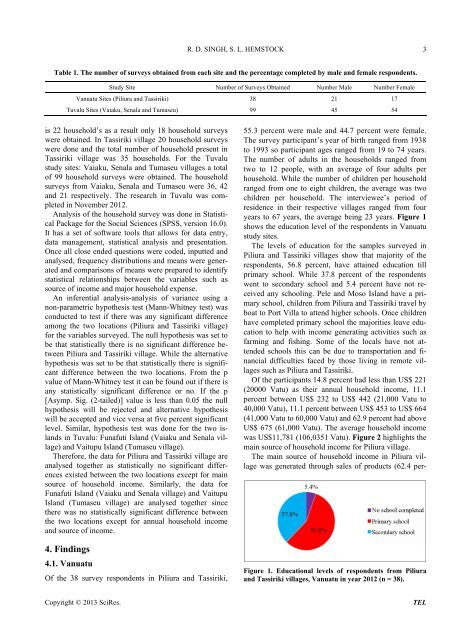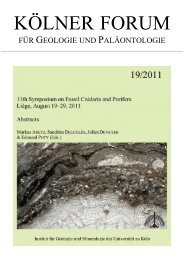Full-Text PDF - Scientific Research Publish
Full-Text PDF - Scientific Research Publish
Full-Text PDF - Scientific Research Publish
Create successful ePaper yourself
Turn your PDF publications into a flip-book with our unique Google optimized e-Paper software.
R. D. SINGH, S. L. HEMSTOCK<br />
3<br />
Table 1. The number of surveys obtained from each site and the percentage completed by male and female respondents.<br />
Study Site Number of Surveys Obtained Number Male Number Female<br />
Vanuatu Sites (Piliura and Tassiriki) 38 21 17<br />
Tuvalu Sites (Vaiaku, Senala and Tumaseu) 99 45 54<br />
is 22 household’s as a result only 18 household surveys<br />
were obtained. In Tassiriki village 20 household surveys<br />
were done and the total number of household present in<br />
Tassiriki village was 35 households. For the Tuvalu<br />
study sites: Vaiaku, Senala and Tumaseu villages a total<br />
of 99 household surveys were obtained. The household<br />
surveys from Vaiaku, Senala and Tumaseu were 36, 42<br />
and 21 respectively. The research in Tuvalu was completed<br />
in November 2012.<br />
Analysis of the household survey was done in Statistical<br />
Package for the Social Sciences (SPSS, version 16.0).<br />
It has a set of software tools that allows for data entry,<br />
data management, statistical analysis and presentation.<br />
Once all close ended questions were coded, inputted and<br />
analysed, frequency distributions and means were generated<br />
and comparisons of means were prepared to identify<br />
statistical relationships between the variables such as<br />
source of income and major household expense.<br />
An inferential analysis-analysis of variance using a<br />
non-parametric hypothesis test (Mann-Whitney test) was<br />
conducted to test if there was any significant difference<br />
among the two locations (Piliura and Tassiriki village)<br />
for the variables surveyed. The null hypothesis was set to<br />
be that statistically there is no significant difference between<br />
Piliura and Tassiriki village. While the alternative<br />
hypothesis was set to be that statistically there is significant<br />
difference between the two locations. From the p<br />
value of Mann-Whitney test it can be found out if there is<br />
any statistically significant difference or no. If the p<br />
[Asymp. Sig. (2-tailed)] value is less than 0.05 the null<br />
hypothesis will be rejected and alternative hypothesis<br />
will be accepted and vice versa at five percent significant<br />
level. Similar, hypothesis test was done for the two islands<br />
in Tuvalu: Funafuti Island (Vaiaku and Senala village)<br />
and Vaitupu Island (Tumaseu village).<br />
Therefore, the data for Piliura and Tassiriki village are<br />
analysed together as statistically no significant differences<br />
existed between the two locations except for main<br />
source of household income. Similarly, the data for<br />
Funafuti Island (Vaiaku and Senala village) and Vaitupu<br />
Island (Tumaseu village) are analysed together since<br />
there was no statistically significant difference between<br />
the two locations except for annual household income<br />
and source of income.<br />
4. Findings<br />
4.1. Vanuatu<br />
Of the 38 survey respondents in Piliura and Tassiriki,<br />
55.3 percent were male and 44.7 percent were female.<br />
The survey participant’s year of birth ranged from 1938<br />
to 1993 so participant ages ranged from 19 to 74 years.<br />
The number of adults in the households ranged from<br />
two to 12 people, with an average of four adults per<br />
household. While the number of children per household<br />
ranged from one to eight children, the average was two<br />
children per household. The interviewee’s period of<br />
residence in their respective villages ranged from four<br />
years to 67 years, the average being 23 years. Figure 1<br />
shows the education level of the respondents in Vanuatu<br />
study sites.<br />
The levels of education for the samples surveyed in<br />
Piliura and Tassiriki villages show that majority of the<br />
respondents, 56.8 percent, have attained education till<br />
primary school. While 37.8 percent of the respondents<br />
went to secondary school and 5.4 percent have not received<br />
any schooling. Pele and Moso Island have a primary<br />
school, children from Piliura and Tassiriki travel by<br />
boat to Port Villa to attend higher schools. Once children<br />
have completed primary school the majorities leave education<br />
to help with income generating activities such as<br />
farming and fishing. Some of the locals have not attended<br />
schools this can be due to transportation and financial<br />
difficulties faced by those living in remote villages<br />
such as Piliura and Tassiriki.<br />
Of the participants 14.8 percent had less than US$ 221<br />
(20000 Vatu) as their annual household income, 11.1<br />
percent between US$ 232 to US$ 442 (21,000 Vatu to<br />
40,000 Vatu), 11.1 percent between US$ 453 to US$ 664<br />
(41,000 Vatu to 60,000 Vatu) and 62.9 percent had above<br />
US$ 675 (61,000 Vatu). The average household income<br />
was US$11,781 (106,0351 Vatu). Figure 2 highlights the<br />
main source of household income for Piliura village.<br />
The main source of household income in Piliura village<br />
was generated through sales of products (62.4 per-<br />
Figure 1. Educational levels of respondents from Piliura<br />
and Tassiriki villages, Vanuatu in year 2012 (n = 38).<br />
Copyright © 2013 SciRes.<br />
TEL
















